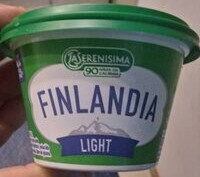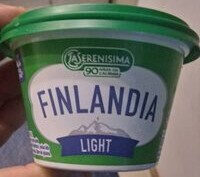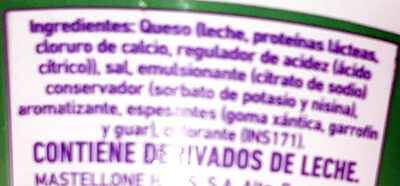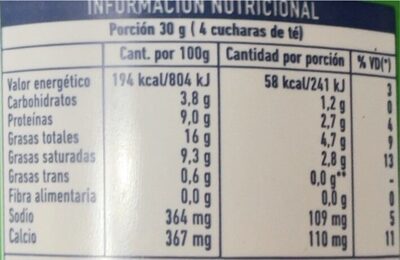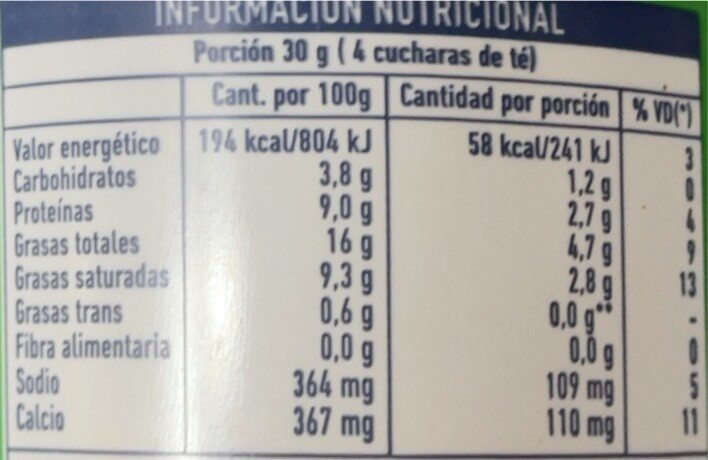Help us make food transparency the norm!
As a non-profit organization, we depend on your donations to continue informing consumers around the world about what they eat.
The food revolution starts with you!
Finlandia light - La Serenisima - 200 g
Finlandia light - La Serenisima - 200 g
This product page is not complete. You can help to complete it by editing it and adding more data from the photos we have, or by taking more photos using the app for Android or iPhone/iPad. Thank you!
×
Barra-kodea: 7790742161802 (EAN / EAN-13)
Kopurua: 200 g
Markak: La Serenisima
Kategoriak: Esneki, en:Fermented foods, en:Fermented milk products, Gazta, en:Spreads, en:Salted spreads, en:Cheese spreads
Origin of ingredients: Argentina
Matching with your preferences
Health
Osagaiak
-
19 ingredients
: Queso [leche, proteínas lácteas, cloruro de calcio, regulador de la acidez (ácido cítrico)], sal, emulsionante (citrato de sodio), conservador (sorbato de potasio, nisina), aromatizante, espesantes (goma xántica, goma garrofín, goma guar), colorante (INS 171)Alergenoak: en:Milk
Food processing
-
Ultra processed foods
Elements that indicate the product is in the 4 - Ultra prozesatutako elikagaiak eta edariak group:
- Gehigarria: E171
- Gehigarria: E410 - Algarrobo-goma
- Gehigarria: E412
- Osagaia: Colour
- Osagaia: Emulsifier
- Osagaia: Flavouring
- Osagaia: Milk proteins
- Osagaia: Thickener
Food products are classified into 4 groups according to their degree of processing:
- Prozesatu gabeko edo ahalik eta gutxien prozesatutako elikagaiak
- Sukaldaritzako osagaiak prozesatu
- Prozesatutako jakiak
- Ultra processed foods
The determination of the group is based on the category of the product and on the ingredients it contains.
Gehigarriak
-
E171
Titanium dioxide: Titanium dioxide, also known as titaniumIV oxide or titania, is the naturally occurring oxide of titanium, chemical formula TiO2. When used as a pigment, it is called titanium white, Pigment White 6 -PW6-, or CI 77891. Generally, it is sourced from ilmenite, rutile and anatase. It has a wide range of applications, including paint, sunscreen and food coloring. When used as a food coloring, it has E number E171. World production in 2014 exceeded 9 million metric tons. It has been estimated that titanium dioxide is used in two-thirds of all pigments, and the oxide has been valued at $13.2 billion.Source: Wikipedia (Ingeles)
-
E202
Potassium sorbate: Potassium sorbate is the potassium salt of sorbic acid, chemical formula CH3CH=CH−CH=CH−CO2K. It is a white salt that is very soluble in water -58.2% at 20 °C-. It is primarily used as a food preservative -E number 202-. Potassium sorbate is effective in a variety of applications including food, wine, and personal-care products. While sorbic acid is naturally occurring in some berries, virtually all of the world's production of sorbic acid, from which potassium sorbate is derived, is manufactured synthetically.Source: Wikipedia (Ingeles)
-
E234
Nisin: Nisin is a polycyclic antibacterial peptide produced by the bacterium Lactococcus lactis that is used as a food preservative. It has 34 amino acid residues, including the uncommon amino acids lanthionine -Lan-, methyllanthionine -MeLan-, didehydroalanine -Dha-, and didehydroaminobutyric acid -Dhb-. These unusual amino acids are introduced by posttranslational modification of the precursor peptide. In these reactions a ribosomally synthesized 57-mer is converted to the final peptide. The unsaturated amino acids originate from serine and threonine, and the enzyme-catalysed addition of cysteine residues to the didehydro amino acids result in the multiple -5- thioether bridges. Subtilin and epidermin are related to nisin. All are members of a class of molecules known as lantibiotics. In the food industry, nisin is obtained from the culturing of L. lactis on natural substrates, such as milk or dextrose, and it is not chemically synthesized. It was originally isolated in the late 1930s, and produced since the 1950s as Nisaplin from naturally occurring sources by Aplin and Barrett in laboratories in Beaminster in Dorset, and approved as an additive for food use in the USA in the late 1960s, although the Beaminster factory now is owned by DuPont.Source: Wikipedia (Ingeles)
-
E330 - Azido zitriko
Citric acid: Citric acid is a weak organic acid that has the chemical formula C6H8O7. It occurs naturally in citrus fruits. In biochemistry, it is an intermediate in the citric acid cycle, which occurs in the metabolism of all aerobic organisms. More than a million tons of citric acid are manufactured every year. It is used widely as an acidifier, as a flavoring and chelating agent.A citrate is a derivative of citric acid; that is, the salts, esters, and the polyatomic anion found in solution. An example of the former, a salt is trisodium citrate; an ester is triethyl citrate. When part of a salt, the formula of the citrate ion is written as C6H5O3−7 or C3H5O-COO-3−3.Source: Wikipedia (Ingeles)
-
E331
Sodium citrate: Sodium citrate may refer to any of the sodium salts of citrate -though most commonly the third-: Monosodium citrate Disodium citrate Trisodium citrateThe three forms of the salt are collectively known by the E number E331. Sodium citrates are used as acidity regulators in food and drinks, and also as emulsifiers for oils. They enable cheeses to melt without becoming greasy.Source: Wikipedia (Ingeles)
-
E410 - Algarrobo-goma
Locust bean gum: Locust bean gum -LBG, also known as carob gum, carob bean gum, carobin, E410- is a thickening agent and a gelling agent used in food technology.Source: Wikipedia (Ingeles)
-
E412
Guar gum: Guar gum, also called guaran, is a galactomannan polysaccharide extracted from guar beans that has thickening and stabilizing properties useful in the food, feed and industrial applications. The guar seeds are mechanically dehusked, hydrated, milled and screened according to application. It is typically produced as a free-flowing, off-white powder.Source: Wikipedia (Ingeles)
Ingredients analysis
-
en:Palm oil free
No ingredients containing palm oil detected
-
en:Non-vegan
Non-vegan ingredients: Gazta, Esne, en:Milk proteins
-
en:Vegetarian status unknown
Unrecognized ingredients: en:Sodium citrate
-
Details of the analysis of the ingredients
: Queso (leche, proteínas lácteas, cloruro de calcio, regulador de la acidez (ácido cítrico)), sal, emulsionante (citrato de sodio), conservador (sorbato de potasio, nisina), aromatizante, espesantes (goma xántica, goma garrofín, goma guar), colorante (e171)- Queso -> en:cheese - vegan: no - vegetarian: maybe - ciqual_proxy_food_code: 12999 - percent_min: 99.99454 - percent_max: 100
- leche -> en:milk - vegan: no - vegetarian: yes - ciqual_proxy_food_code: 19051 - percent_min: 24.998635 - percent_max: 100
- proteínas lácteas -> en:milk-proteins - vegan: no - vegetarian: yes - percent_min: 0 - percent_max: 50
- cloruro de calcio -> en:e509 - vegan: yes - vegetarian: yes - percent_min: 0 - percent_max: 33.3333333333333
- regulador de la acidez -> en:acidity-regulator - percent_min: 0 - percent_max: 25
- ácido cítrico -> en:e330 - vegan: yes - vegetarian: yes - percent_min: 0 - percent_max: 25
- sal -> en:salt - vegan: yes - vegetarian: yes - ciqual_food_code: 11058 - percent_min: 0 - percent_max: 0.00091
- emulsionante -> en:emulsifier - percent_min: 0 - percent_max: 0.00091
- citrato de sodio -> en:sodium-citrate - percent_min: 0 - percent_max: 0.00091
- conservador -> en:preservative - percent_min: 0 - percent_max: 0.00091
- sorbato de potasio -> en:e202 - vegan: yes - vegetarian: yes - percent_min: 0 - percent_max: 0.00091
- nisina -> en:e234 - vegan: yes - vegetarian: yes - percent_min: 0 - percent_max: 0.00091
- aromatizante -> en:flavouring - vegan: maybe - vegetarian: maybe - percent_min: 0 - percent_max: 0.00091
- espesantes -> en:thickener - percent_min: 0 - percent_max: 0.00091
- goma xántica -> en:e415 - vegan: yes - vegetarian: yes - percent_min: 0 - percent_max: 0.00091
- goma garrofín -> en:e410 - vegan: yes - vegetarian: yes - percent_min: 0 - percent_max: 0.00091
- goma guar -> en:e412 - vegan: yes - vegetarian: yes - percent_min: 0 - percent_max: 0.00091
- colorante -> en:colour - percent_min: 0 - percent_max: 0.00091
- e171 -> en:e171 - vegan: yes - vegetarian: yes - percent_min: 0 - percent_max: 0.00091
- Queso -> en:cheese - vegan: no - vegetarian: maybe - ciqual_proxy_food_code: 12999 - percent_min: 99.99454 - percent_max: 100
Elikadura
-
Missing data to compute the Nutri-Score
Missing nutrition facts
⚠ ️The nutrition facts of the product must be specified in order to compute the Nutri-Score.Could you add the information needed to compute the Nutri-Score? Add nutrition facts
-
Nutrient levels
-
Koipe in moderate quantity (16%)
What you need to know- A high consumption of fat, especially saturated fats, can raise cholesterol, which increases the risk of heart diseases.
Recommendation: Limit the consumption of fat and saturated fat- Choose products with lower fat and saturated fat content.
-
Gantz-azido ase in high quantity (9.3%)
What you need to know- A high consumption of fat, especially saturated fats, can raise cholesterol, which increases the risk of heart diseases.
Recommendation: Limit the consumption of fat and saturated fat- Choose products with lower fat and saturated fat content.
-
Gatz arrunt in low quantity (0.00091%)
What you need to know- A high consumption of salt (or sodium) can cause raised blood pressure, which can increase the risk of heart disease and stroke.
- Many people who have high blood pressure do not know it, as there are often no symptoms.
- Most people consume too much salt (on average 9 to 12 grams per day), around twice the recommended maximum level of intake.
Recommendation: Limit the consumption of salt and salted food- Reduce the quantity of salt used when cooking, and don't salt again at the table.
- Limit the consumption of salty snacks and choose products with lower salt content.
-
-
Nutrition facts
Nutrition facts As sold
for 100 g / 100 mlAs sold
per serving (30g)Compared to: en:Cheese spreads Energia 804 kj
(194 kcal)241 kj
(58 kcal)-% 13 Koipe 16 g 4,8 g -% 14 Gantz-azido ase 9,3 g 2,79 g -% 26 Trans fat 0 g 0 g Carbohydrates 3,8 g 1,14 g -% 3 Azukre ? ? Fiber 0 g 0 g -% 100 Proteina 9 g 2,7 g +% 4 Gatz arrunt 0,001 g 0 g -% 100 Kaltzio 0,367 mg 0,11 mg -% 100 Fruits‚ vegetables‚ nuts and rapeseed‚ walnut and olive oils (estimate from ingredients list analysis) 0 % 0 %
Ingurumena
-
Eco-Score D - High environmental impact
The Eco-Score is an experimental score that summarizes the environmental impacts of food products.→ The Eco-Score was initially developped for France and it is being extended to other European countries. The Eco-Score formula is subject to change as it is regularly improved to make it more precise and better suited to each country.Life cycle analysis
-
Average impact of products of the same category: C (Score: 56/100)
Kategoria: Uncured soft cheese, spreadable, around 25% fat, in a tub
Kategoria: Uncured soft cheese, spreadable, around 25% fat, in a tub
- PEF environmental score: 0.47 (the lower the score, the lower the impact)
- including impact on climate change: 4.98 kg CO2 eq/kg of product
Stage Impact Agriculture
83.3 %Processing
6.2 %Ontziratzea
4.6 %Transportation
3.5 %Distribution
1.9 %Consumption
0.5 %
Bonuses and maluses
-
Origins of ingredients with a high impact
Malus: -3
Environmental policy: -3
Transportation: 0
Origin of the product and/or its ingredients % of ingredients Impact Argentina 100 %Altua
-
Missing packaging information for this product
Malus: -15
⚠ ️ The information about the packaging of this product is not filled in.⚠ ️ For a more precise calculation of the Eco-Score, you can modify the product page and add them.
If you are the manufacturer of this product, you can send us the information with our free platform for producers.
Eco-Score for this product
-
Impact for this product: D (Score: 38/100)
Produktua: Finlandia light - La Serenisima - 200 g
Life cycle analysis score: 56
Sum of bonuses and maluses: -18
Final score: 38/100
-
Carbon footprint
-
Equal to driving 2.6 km in a petrol car
498 g CO² per 100g of product
The carbon emission figure comes from ADEME's Agribalyse database, for the category: Uncured soft cheese, spreadable, around 25% fat, in a tub (Source: ADEME Agribalyse Database)
Stage Impact Agriculture
84.0 %Processing
5.6 %Ontziratzea
5.3 %Transportation
4.2 %Distribution
0.7 %Consumption
0.1 %
Ontziratzea
-
Missing packaging information for this product
⚠ ️ The information about the packaging of this product is not filled in.Take a photo of the recycling information Take a photo of the recycling information
Transportation
-
Origins of ingredients
Origins of ingredients with a high impact
Origin of the product and/or its ingredients % of ingredients Impact Argentina 100 %Altua
Report a problem
-
Incomplete or incorrect information?
Category, labels, ingredients, allergens, nutritional information, photos etc.
If the information does not match the information on the packaging, please complete or correct it. Open Food Facts is a collaborative database, and every contribution is useful for all.
Datuen iturria
Product added on by elcoco
Last edit of product page on by thaialagata.
Produktuaren orria -gatik editatua elcoco.9954e9d939d9ac95ac828887dc0bcb8b, flipwared, jalabaster, kiliweb, openfoodfacts-contributors, yuka.SGJnaUVMbzQvYVJSeHMwQXJoZnQxK3dxeWEyMlF6cVdDTUVRSWc9PQ, yuka.sY2b0xO6T85zoF3NwEKvlmV6Tvbh-Q74FhvQwUikm_S2Er_IfPVOvKvFHqs.
